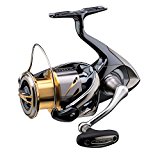Introduction to Guadalupe Bass Fishing
Guadalupe Bass seek out and are found in flowing waters of streams around large rocks, cypress knees, stumps and similar types of cover.
The Guadalupe Bass (Micropterus treculii) is a member of the Centrarchidae family and is very similar to the spotted bass. Micropterus is Greek for ‘small fin’ while the Greek word treculi refers to Trecul, the French compatriot of Vaillant and Bocourt. It was not until 1963 that the Guadalupe Bass was recognized as a separate species of Bass.
The Guadalupe Bass is a rare bass species. Until recently, it was classified as vulnerable. We highly recommend practizing catch and release with the Guadalupe Bass until sufficient numbers have removed their status from rare.
In the 1970s, the smallmouth bass was introduced into the same distribution as the Guadalupe Bass. Shortly thereafter they began to breed together and hybridization occurred as much as 50 percent of the population. The state has since created a program to protect them from hybridization through various breeding situations.
The appearance of the Guadalupe Bass is similar in appearance to the Spotted Bass. It has around 11 dark bars along its sides that become less visible as they get older. This is not at all a large game fish with the record all-tackle record being three pounds, 11 ounces.
The Guadalupe Bass is also not a very popular fish as it is restricted to the Edwards Plateau, Guadalupe, San Antonio and the upper Nueces river drainages found in southern Texas. All these streams are rather small, which is the main reason why the bass don’t grow large – there simply is not enough of an ecosystem to support a larger fish. When it comes to Texas bass fishing, the largemouth bass is king with the Guadalupe bass take a distanct third. However, while they are small, they put up a great fight and are a desirable sport fish in southern Texas.
Preferred environments are small still water environments commonly found in flowing water, which may sound contradictory, but they stay out of the fast moving water in pools and raffles or by hiding behind rocks and they do this all day where they congregate and wait to ambush prey fish. The Guadalupe Bass is not afraid of rapids and when found there, they are often found near eddies.
They can also be found in turbid downstream sections of rivers that have gravel riffles and at heads of deep pools that often have a silt substrate.
Temperature
They seek out and are found in flowing waters of streams around large rocks, cypress knees, stumps and similar types of cover for refugia. Water temperatures in their habitat range from 39°F/4°C degrees in the winter to as much as 95°F/35°C degrees in the summer.
The Guadalupe Bass is the state fish of Texas and there is a good sport fishing tourism market built around this fish. Being a small fish, they make up for their lack of size with a good fight.
Other Bass
Compared to the Peacocks and Niugini Bass the Guadalupe Bass hit hard and don’t give up easy. Heavy tackle is not required for this fish, nor is a heavy line. The cost to fish for the Guadalupe Bass is not significant and perfect for the weekend angler. While Peacocks and the Niugini Bass are great fighting fish and offer an incredible fight, the costs are much greater as they are often located in remote areas, require heavy gear as well as spare gear and take some planning to land.
For children and those just interested in fishing the odd weekend, this is an excellent bass to learn to fish. We recommend no more than an 8lb test line and a simple baitcaster rod and reel combination will work well. Try a Cardinal reel with a graphite combination rod.


